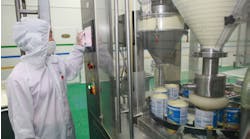I watched the Great American Eclipse last year from Casper, Wyo.; it was spectacular. The response of the crowd there that experienced this event was even more enlightening and unexpected. The science behind the eclipse is well-known and was widely publicized, so what happened was exactly as anticipated. Yet, people cheered as if their favorite team just scored the winning touchdown. Some cried as if they had lost a loved one. This put a chill in my body that wasn’t due to the 20° drop in temperature. I wondered why the crowd’s reaction reminded me of some industrial experiences I’ve had in working with particulate solids.
[pullquote]
Have you watched a crystallizer flash over to an opaque mass that ruined the batch? Have you had your mixed solids segregate by size coming out of your blender? Do the elbows of your pneumatic conveyor wear out every three months? Is your dryer product sticky some of the time, even if the moisture out of the dryer is correct? The answers to all of these questions aren’t any more magical than an eclipse. Well-known scientific principles explain the actions of particulate solids.
In batch crystallization, we know that exceeding the meta-stable zone can create many different types of problems. The most common difficulty is the formation of too many fine particles; this depletes the solute so there isn’t enough super-saturation for growth of the particles. The problem gets worse if the meta-stable zone is very narrow or never was studied during process development. Polymorphs can have different solubility curves that cross at a given temperature. If cooling of the unsaturated solution begins above this temperature, the unstable polymorph will form and the batch will produce the wrong product. This behavior often surprises operators even when they are familiar with the principles behind the outcome.
We all realize that blending is a complicated mix of time and blender configuration. The common approach for getting better results is to lengthen the blend time. Instead, you should alter the flow patterns in the blender to prevent funnel flow or introduce more shear between particles. To know what specifically to do, you must conduct flowability studies to select the correct angle, internal baffles and material of construction to achieve the correct flow patterns.
We also appreciate that the secret to elbow design is controlling the velocity of the particles. Many years ago, it was considered magic that a short-radius elbow or even a T-bend would outperform a long sweeping elbow in pneumatic conveyors. In theory, the long-radius would gently move the particles along the wall and slow them. However, research showed that the particles bounced in a manner that created more wall damage than expected. One operator I knew kept patching long-radius elbows until they stopped wearing out, only to find that they then resembled funny looking short-radius elbows. Since then, some research on the subject has confirmed this wear issue.
We know that release of internal moisture can take place long after drying, making the product sticky. Unfortunately, this is too common a problem. Yet operators still are surprised when it happens. I usually ask the operators if they have a drying curve for the material — they very seldom do. What they get from development is a fixed time with a given inlet temperature. How about equilibrium moisture content as a function of humidity as a starter? Yes, they will have a final specification for moisture content but this often is only surface moisture and after the material has been discharged from the dryer. Average moisture as a measurement seldom suffices because some particles can be very wet while others are excessively dry. Upon storage, the wet particles stick to the dry particles, creating lumps.
I’ve found that the operators and process engineers running plants generally have a good understanding of the principles of particle behavior. However, they frequently resort to various rash or impulsive fixes when encountering a problem. Then, confronted with an explanation using these principles, they often appear stunned that science really works — just like the observers of an eclipse.



